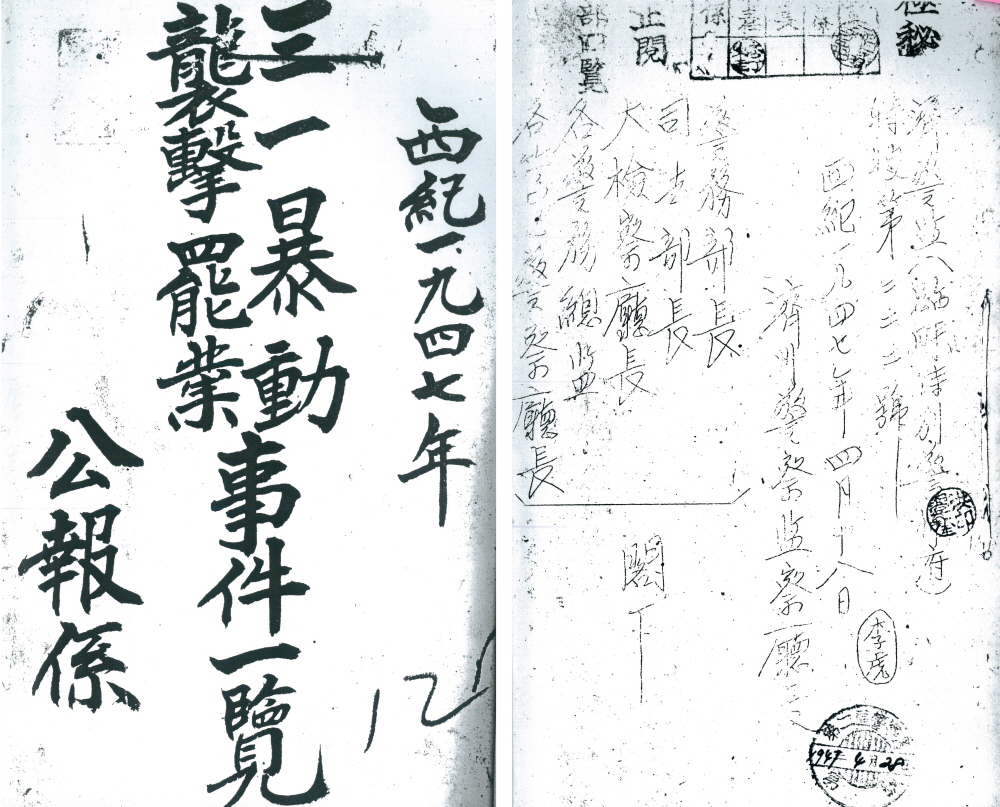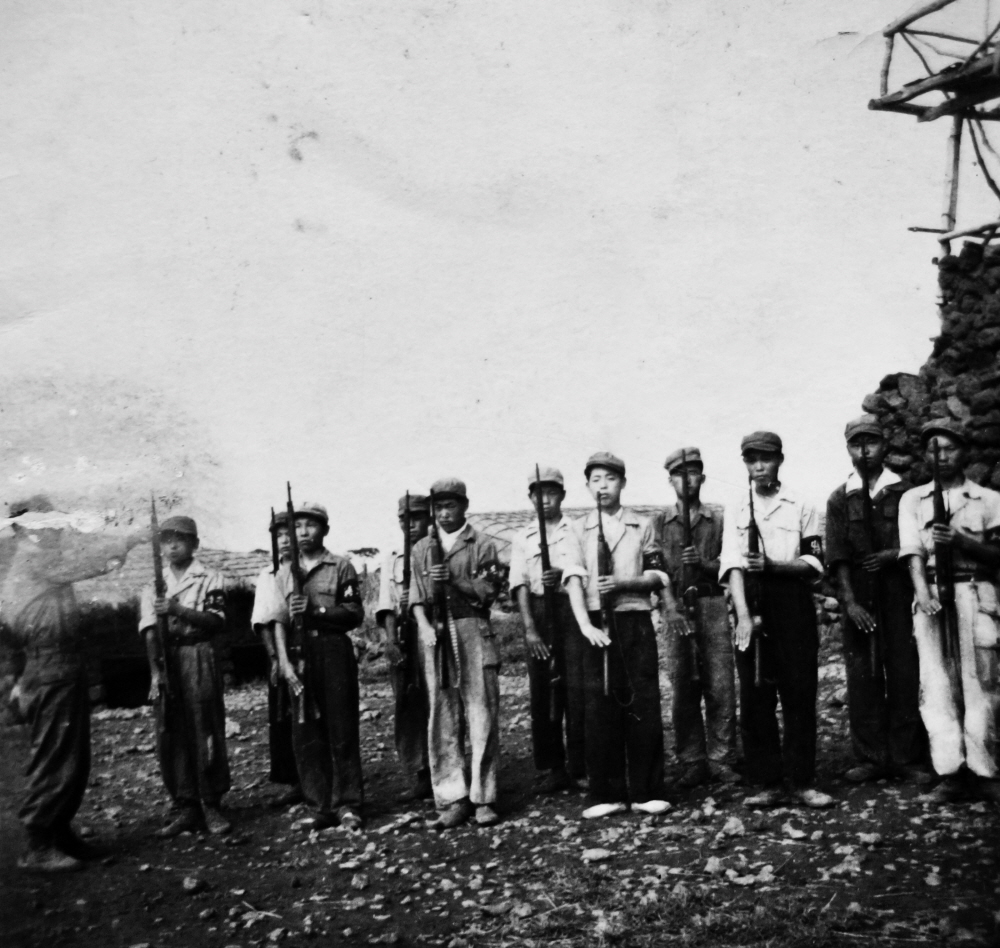‘Jeju 4·3 Additional Investigation Report’ Published 16 Years after First National Government Report

The document contains the classified report that Jeju Police inspector general made on April 28, 1947, addressed to the USAMGIK Jeju Police chief, the USAMGIK Justice Bureau director, and the USAMGIK prosecutor general concerning the March 1 Incident and the following March 10 General Strike of that year. The police defined its ill-advised shooting of civilians and their response as “March 1 Rioters’ Attack.”
– Jeju 4‧3 Peace Foundation Reveals 26 Cases of Massacres of 50 or More People
– Damage Caused to 165 Villages Clarified, Including Disappeared, Imprisoned, and Preliminarily Arrested Victims
The national government released “The Jeju April 3rd Incident Investigation Report” in 2003. Sixteen years have since passed, and the first set of findings of additional investigation was recently released in “Jeju 4·3 Additional Investigation Report Vol. 1.” The report unveiled the newly classified massacres of 50 or more people and the damage caused to 165 villages during Jeju 4·3. With the second and the third volumes planned to be published, the report is expected to help clarify the truth of the past events.
The first volume details a vast range of damages to villages, as well as the cases of massacres, disappearances of prisoners, and preliminary arrests. It also addresses the excavation of the remains of missing victims, the damage caused to the educational sector, and the deaths and injuries caused by the military, police, and right-wing militias.
Particularly, the researchers conducted a complete enumeration survey on the damage caused to 165 villages (ri) in 12 districts (eup/myeon). The 14,442 people who have been identified as victims as of December 2019 were described in a total of 18 categories, depending on the classification of perpetrators, type of damage incurred, style of court case, and success or failure in recovering their remains. In the additional investigation, the research team also discovered that more than 1,200 victims had yet to be reported on.
The findings concerning the damage to villages show that there were as many as 26 massacre cases on Jeju where 50 or more people were killed at one site. The researchers identified each of the victims. The individual homicide cases with 49 or fewer victims were also included in the category if mass murder cases occurred repeatedly on the same site.
The investigation on missing victims revealed that 4,255 people disappeared due to Jeju 4·3, 645 more than the current 3,610 people the National Committee for Investigation of the Jeju 4.3 Incident and Restoring the Honor of the Victims had confirmed. “The Jeju 4·3 Additional Investigation Report” explained, “In many cases, victims whose remains had not been discovered were reported as deceased victims.”
Also clarified in the additional investigation was the damage caused to the 2,261 people who disappeared after being sent to prisons. Particularly, the investigation found what happened to the missing prisoners who had been detained in the Gyeongin and Honam regions on the Korean mainland.
According to the investigation of the preliminary arrest cases, 566 people were victimized in 1950 immediately after the Korean War broke out. The cases of only 53 victims have been clarified, including 40 whose remains were excavated and 13 who died due to detainment or torture. The personal information and whereabouts of the remaining 513 people remain unknown, the report indicated.
In terms of the educational sector, the report documented a total of 700 cases, including the deaths and injuries of 271 teachers and 429 students, as well as material damage such as facility destruction and operating losses to 93 schools.
The researchers also discovered that the attacks by the military, police, and right-wing militias resulted in 1,091 victims, of which the military was responsible for 162, the police were responsible for 289, and the right-wing militias were responsible for 640 deaths. Compared to the 2003 report of 1,051 victims (180 by military, 232 by police, 639 by right-wing groups), the number caused by the military reduced while those attributed to police attacks slightly increased.
So far, 14,442 victims of Jeju 4·3 have been classified based mainly on their legal domiciles. Through the complete enumeration survey, the new report reclassified the victims depending on their actual residential addresses during Jeju 4·3. When using the victims’ legal domiciles, errors may occur in assessing damage because the damaged regions and the victims’ residences differ in several cases.
 As a result of the new investigation, the number of victims by village has been adjusted. Nohyeong, the village with the highest number of victims, experienced a slight decrease from 544 to 538 victims, while the number of victims in Bukchon and Gasi Villages increased from 419 to 446 and 407 to 421, respectively. The new report also renewed the Map of Jeju 4·3 Victims by Village, which is based on the victims’ legal domiciles, to reflect the residential information.
As a result of the new investigation, the number of victims by village has been adjusted. Nohyeong, the village with the highest number of victims, experienced a slight decrease from 544 to 538 victims, while the number of victims in Bukchon and Gasi Villages increased from 419 to 446 and 407 to 421, respectively. The new report also renewed the Map of Jeju 4·3 Victims by Village, which is based on the victims’ legal domiciles, to reflect the residential information.
If the first report published in 2003 at the national level is a general report on the truth of Jeju 4·3, the newly released additional document would be considered an itemized report. The latest report is significant in that it attempts an in-depth research of the truth of Jeju 4·3 by investigating the damages more specifically. Assuming that the national report is the bones, the additional report could be viewed as adding flesh to those bones.
After taking the responsibility of conducting additional investigation under the Jeju 4·3 special act, the Jeju 4·3 Peace Foundation constituted the Additional Investigation Group (led by Park Chan-shik), which launched in 2012 to research the damage of Jeju 4·3 by village and sector until 2016. In October 2018, the Investigation and Research Lab opened within the foundation. The investigation group formed the Additional Investigation Report Writing Team (led by Yang Jeong-shim) and complemented the existing investigation to finally publish “Jeju 4·3 Additional Investigation Report Vol. 1.” Before its release, the report was reviewed by Seo Joong-seok (Professor Emeritus of Sungkyunkwan University), a scholar specializing in Korean modern history.
The latest report does not address the role or responsibility of the United States in Jeju 4·3, the victims who were imprisoned in the central and Yeongnam regions on the Korean mainland, or the damage caused to overseas Koreans or religious groups. The Jeju 4·3 Peace Foundation plans to release the second and the third volumes of the new report on these issues following additional investigation.
Meanwhile, former Prime Minister Lee Nak-yon wrote in his words of encouragement that the Jeju 4·3 Peace Memorial Hall has a gravestone without an epitaph, which expresses the will to inscribe it with the true name of Jeju 4·3 and erect it one day. Lee said that it is his belief that the recent publication of the additional report will be an important step toward filling the stone with its proper name.
Jeju Governor Won Heeryong also stated in his words of encouragement that the additional report will help clarify the truth of Jeju 4·3 and straighten the island’s history. Finally, he expressed high hopes that the report will contribute greatly to restoring the honor to the victims and their bereaved families.